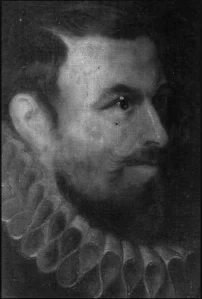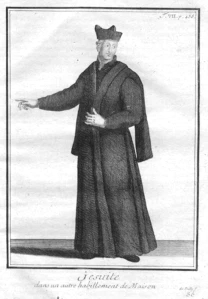
Not quite Ballard as Black Foskew – but… an approximation
What can I say? Much as I love Cate Blanchett and Geoffrey Rush, I can never watch Elizabeth without cringing at what Hirst, Kapur and Craig together managed to make of Father John Ballard – in terms of both historical accuracy and characterisation.
Because, Hirst’s vagaries apart, all we know of John Ballard points to a rather more complicated and fascinating character than Daniel Craig’s impassive (and quite possibly mad) fanatic. A Suffolk Catholic, young John went to Cambridge, graduated at St. Catherine and then moved to Caius, a college with a doubtful name, considering its Catholic second founder and several alumni… By 1579, perhaps having had enough leading the recusant’s life at home, he fled to France, where he entered the English Seminary in Rheims. He was ordained as a priest in 1581.

A Jesuit
A Jesuit priest, it seems – although I’ve read recently that there might be some doubt about this. I confess I’d be surprised and a little disappointed. English Jesuits out of Rheims and Douai were most active in the matter of crypto-Catholicism: they travelled back to England under false names, smuggled in incendiary religious tracts, lived in hiding, celebrated clandestine masses… all of which amounted to treason, quite the capital offence. In Elizabeth’s England being a Catholic was costly and awkward, but not forbidden; practicing Catholicism, though, was another matter. Indeed, most of these “missionaries” back from France, after a colourful career filled with flights, disguises, uncomfortable sojourns in some priest’s hole, betrayals and pursuits, were caught, imprisoned and sent to an extremely unpleasant end. The English Martytology is filled with Jesuit missionaries, such as Edmund Campion and Robert Southwell – just to name a few. John Ballard is not in that list, though – and with good reason: Ballard wasn’t content with preaching and celebrating mass. He wanted Elizabeth dead and England conquered.
So he began a Europe-trotting life as a recruiter and schemer, shuttling between the Papal court, the Spanish ambassador Bernardino de Mendoza, Mary Stuart’s agents, the English Catholics… He kept telling the latter that Rome and Madrid were ready to act the moment England rose against Elizabeth, and everyone else that England was ready to rise the moment Rome and Madrid acted… One imagines him as a charismatic, eloquent man. It seems that the wily Mendoza was a tad wary – but everyone else listened in rapt fascination.

Poor Anthony
Then in 1584 Father Ballard landed in England – very secretly, of course – for a campaign of clandestine masses and exorcisms. And perhaps we don’t entirely grasp the impact of such a thing, but the English Catholics were swept off their collective feet. Again, Ballard was quite the performer: commoners and gentry crowded his meetings, and among the others was a rather excitable young gentleman called Anthony Babington. It took a Mendoza to resist Ballard’s charm. Young, hot-headed and hero-worshipping Babington fell completely under the spell.
He was sorely disappointed when Ballard soon left for the Continent again to resume his travels and campaigning: the Pope in Rome, Mendoza and Mary’s men in Paris… His game never changed much: to everyone he told what he wished were the truth – what he was convinced would become the truth with some nudging and pushing…
In 1586 he was back in England, charged with the preparation of a Catholic insurrection. They were in earnest, this time, and Ballard lost no time gathering a following of wildly high-flown young men – first and foremost Babington. To avoid suspicion and move freely about, our daring Jesuit adopted the alias of Captain Fortescue, a silk-wearing soldier known to his acquaintances as Black Foskew for his swarthy complexion and a penchant for black finery.

The plotters plot
Still, neither a good actor nor a fiery zealot make necessarily for a good conspirator. Captain Fortescue never suspected that his inseparable companion, a man named Bernard Maude, was a Queen’s man. And Babington’s confidant, Robin Poley? Another agent. Moreover, when it dawned on him that Ballard’s plans included the small matter of murdering the Queen, Babington grew nervous, and unwary, and loose-tongued.
Not that it would have made much difference, most likely. The plot was doomed from the start, and if it got as far as it did, it was because Elizabeth’s spymaster, Sir Francis Walsingham, wanted to use it to seal Mary Stuart’s fate. And indeed, Ballard had instructions to secure the support of the Scots Queen who, uncharacteristically wary at first, ended up compromising herself in full. As soon as Walsingham had Mary’s incriminating letter in his hands, the game was up.
Ballard was caught first, but soon Babington and the others joined their leader. They were all tortured – although there was precious little left to uncover by then. Within days, Ballard, Babington and four others where hanged, drawn and quartered – the whole process so horrific that it shocked even the usually blood-thirsty London crowds.

In the end…
Mary Stuart was tried for treason, found guilty and beheaded the following February. The plot that should have freed and crowned her – and instead ended in her death – is still named after its weak link: the Babington Plot. Don’t you think it should rather bear the name of John Ballard, the charismatic leader who built it all on a scaffold of exaggerations, eloquence, and half-lies, and then gave it all away out of blind recklessness and misplaced trust?
